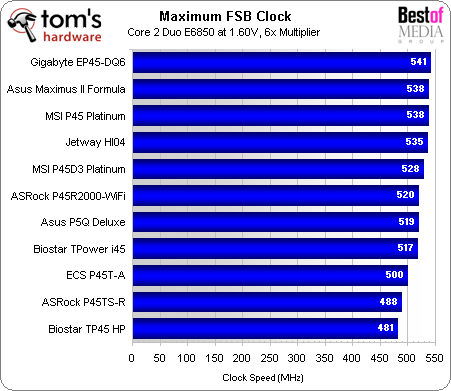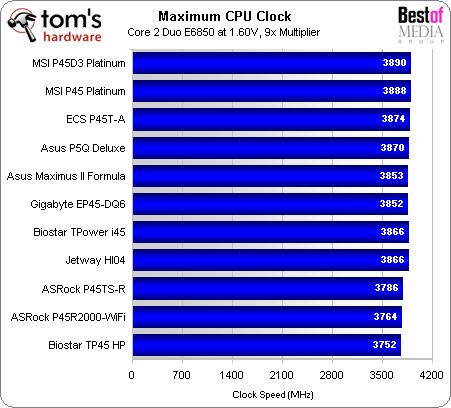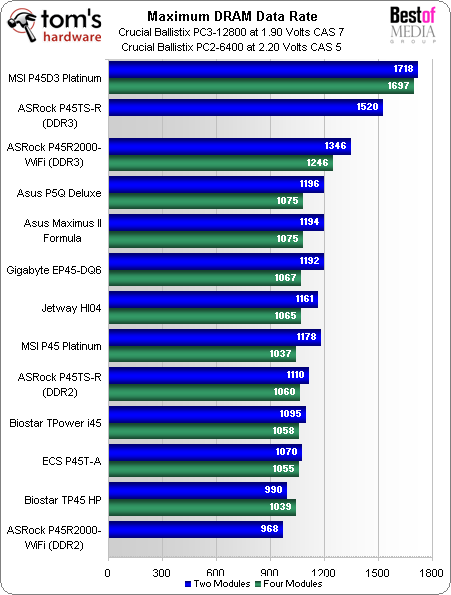11-Way P45 Motherboard Shootout
Overclocking
Gigabyte wins the FSB contest when all motherboards use the same settings. We’ve seen claims by another company to FSB clocks exceeding 700 MHz, but those records were set by professional overclockers using extreme cooling, and might have even required hardware modification.
Since every motherboard in today’s comparison was capable of pushing a higher FSB clock than our processor could withstand at its highest multiplier, CPU clock speed is instead restricted by other factors such as VRM stability. You’d expect the highest stable CPU clock to be reached using the 16-phase power regulator of Asus or Gigabyte, but instead we find MSI’s 6-phase products taking first and second place with our dual-core processor. We might have had a different winner had we used a Core 2 Quad, or perhaps not.
The MSI P45D3 Platinum was the only “true” DDR3 motherboard in today’s comparison, and it pushed our DDR3-1600 CAS 8 memory to very respectable CAS 7 speeds. The dual-compatibility motherboards couldn’t even reach the rated speed of these modules.
Asus leads the way among DDR2 motherboards, but Gigabyte, Jetway, and MSI aren’t far behind. The two Asus motherboards were also the only ones we’d trust to run four DDR2-1066 modules, although it’s better stay with a single pair whenever possible.
Get Tom's Hardware's best news and in-depth reviews, straight to your inbox.
-
nickchalk Where are the lower price P45 M/B ?Reply
Asus P5Q pro is out for €110 and P5Q deluxe for €165 the price difference is about 70$ in Greece. -
Proximon I suppose I can get some good from having read this. Did you get paid by the word? Maybe next time you could just put together a complete features chart so that we can have some convenient comparison? You know, so someone could go to a chart and see at a glance which boards had eSATA or firewire, or 8 USB.Reply
-
JPForums I'd rather have the overabundance of information than a lack of information. Presentation could use a little refining (I.E. comparison charts and the likes), but having the relevant information available at least is a good thing.Reply -
the introduction and specifics are nice, the comparision isn't. so, why don't you test with an 8500 or qx9650? 6850 are outdated... and a mobo handling a c2d doesn't mean it can handle a quad too, see P5K for example (it stinks when it comes to a q6600).Reply
-
Crashman procithe introduction and specifics are nice, the comparision isn't. so, why don't you test with an 8500 or qx9650? 6850 are outdated... and a mobo handling a c2d doesn't mean it can handle a quad too, see P5K for example (it stinks when it comes to a q6600).Reply
Tom's Hardware wants the performance of current articles to reflect that of recent articles, so a "standard test platform" was chosen a while ago. It will get updated, but probably not before the new socket becomes widely available. -
zenmaster I would have liked to see something such as a P35 and an X48 as controls to help analyze the P45 Performance.Reply
In otherwords, What is the P45 Gaining me over the older P35.
What would I gain by going to the X48. (Or Lose) -
Crashman zenmasterI would have liked to see something such as a P35 and an X48 as controls to help analyze the P45 Performance.In otherwords, What is the P45 Gaining me over the older P35.What would I gain by going to the X48. (Or Lose)http://www.tomshardware.com/reviews/intel-p45-chipset,1961.htmlReply -
johnbilicki The first 17 pages were filled with nothing but junk from ASUS. Do us a favor: don't even bother featuring or *MENTIONING* anything for any reason from a company that refuses to RMA 200-400 dollar brand new motherboards with anything other then used and usually broken junk. It destroyed my enthusiasm for the article.Reply -
dobby nickchalkWhere are the lower price P45 M/B ?Asus P5Q pro is out for €110 and P5Q deluxe for €165 the price difference is about 70$ in Greece.Reply
the p5q PRo is a p43 board, i should know i have one



